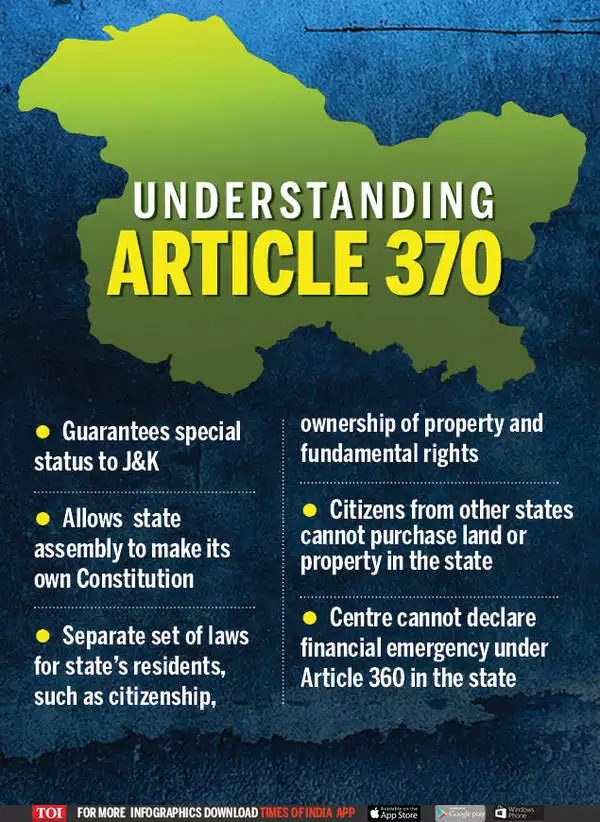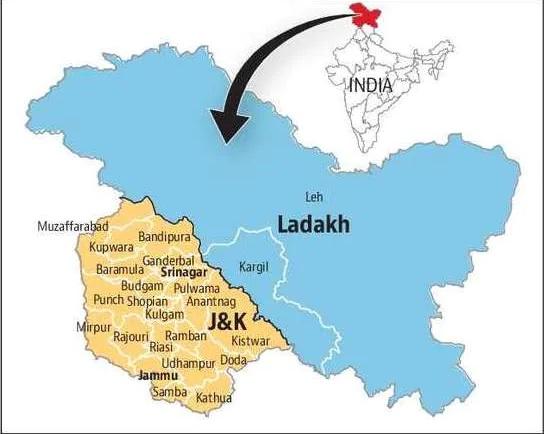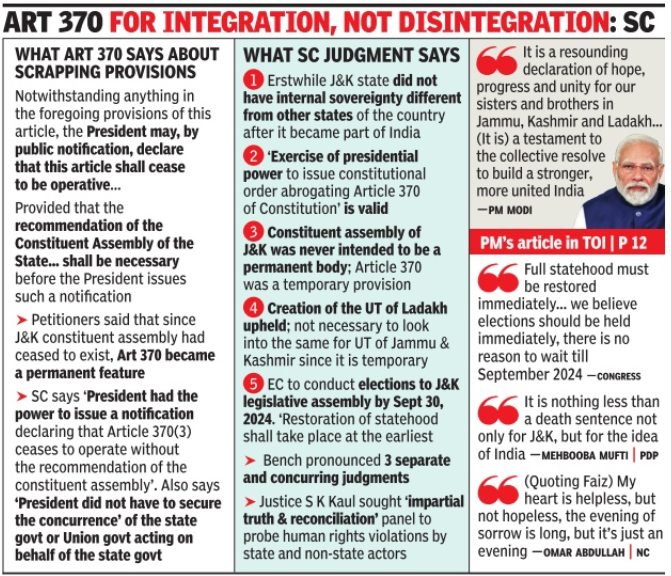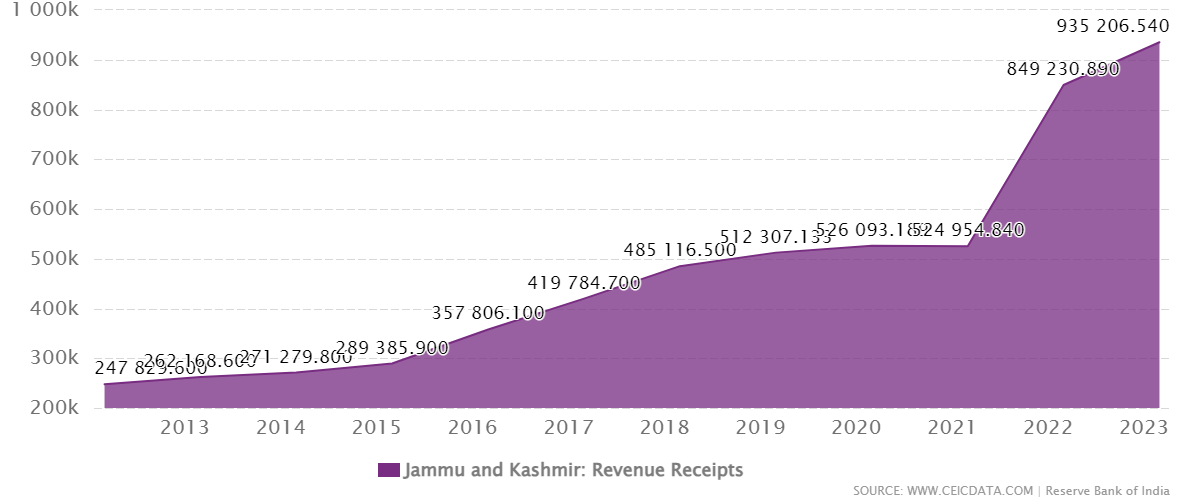Indian Polity
Article 370: Decoding the Supreme Court Verdict
- 13 Dec 2023
- 14 min read
This editorial is based on “Today, a clean canvas for every child in J&K” which was published in The Indian Express on 12/12/2023. The article argues that the verdict is a historic and landmark judgment that upholds the sovereignty and integrity of India and the will of the people of Jammu and Kashmir.
For Prelims: Articles 370 and 35A, Supreme Court, Special Status, Jammu and Kashmir Reorganisation Act, 2019, SR Bommai v Union of India, 1994, Prime Minister's Development Package (PMDP), Industrial Development Scheme (IDS),
For Mains: Articles 370, Supreme Court’s decision, Reasons behind abrogation of Article 370, impact of abrogation of Article 370
On 11th December 2023, the Hon’ble Supreme Court of India delivered a historic judgment on the abrogation of Articles 370 and 35A. Through its judgment, the Court has upheld the sovereignty and integrity of India, something that every Indian cherishes. The Supreme Court observed that the decision taken on 5th August 2019 to abrogate Article 370 which ended the special status of the erstwhile state of J&K, was done to enhance constitutional integration and not disintegration. The Court has also recognised the fact that Article 370 was not permanent in nature.
What was Article 370 About?
- Article 370 in the Indian constitution gave special status to Jammu and Kashmir, a region disputed by India, Pakistan and China.
- It was drafted by N Gopalaswami Ayyangar, a member of the Constituent Assembly of India, and was added to the constitution as a ‘temporary provision’ in 1949.
- It allowed the state to have its own constitution, flag and autonomy over most matters except defence, foreign affairs and communications.
- It was based on the terms of the Instrument of Accession, which was signed by the ruler of Jammu and Kashmir, Hari Singh, in 1947 to join India after an invasion by Pakistan.
How did the Government Repeal Article 370?
- Presidential Order: In the 2019 Presidential orders, Parliament brought a provision giving new meaning to “constituent assembly of Jammu and Kashmir”, to mean “Legislative Assembly of Jammu and Kashmir”, and then assumed the powers of the Legislative Assembly through the President's rule to revoke Article 370.
- Resolutions in Parliament: Concurrent resolutions were passed by both houses of the Parliament, the Lok Sabha and the Rajya Sabha, on 5th and 6th August 2019, respectively. These resolutions revoked the remaining provisions of Article 370 and replaced them with new provisions.
- Jammu and Kashmir Reorganisation Act: The Jammu and Kashmir Reorganisation Act, 2019, was passed by Parliament on 5th August 2019. This act bifurcated the state of Jammu and Kashmir into two Union Territories: Jammu and Kashmir and Ladakh.
What did the Court Say?
- Art 370 was a Temporary Provision: The court held that Article 370 was a temporary provision and that the State of J&K had no internal sovereignty.
- The court held that Article 370 was meant to be a ‘temporary provision’ for two primary reasons.
- It served a transitional purpose which was to make an interim arrangement to establish a Constituent Assembly of J&K which would draft the State Constitution.
- It was meant to ease the integration of J&K into the Union of India in the light of the prevailing war-like situation in the State back in 1947.
- The court held that Article 370 was meant to be a ‘temporary provision’ for two primary reasons.
- Governor can Assume “all or any” Roles of the State Legislature: The court upheld the proclamations by referring to the landmark 1994 ruling in ‘SR Bommai v Union of India, 1994’ which dealt with the powers and limitations of the Governor under President’s rule.
- The CJI said that the governor (President in J&K’s case) can assume “all or any” roles of the state legislature and such action must be tested judicially only in extraordinary cases.
- Concurrence of the State Government isn’t Required: The court ruled that the President in the exercise of powers under Article 370 (3) of the Constitution can unilaterally notify that Article 370 ceases to exist.
- It further said that there was no requirement for the President to secure the concurrence of the State government in this regard as mandated by the provisos to Article 370(1)(d).
- Upheld the 2019 Law: The court upheld the Jammu and Kashmir Reorganisation Act, 2019 to the extent it carved out the Union Territory of Ladakh out of the State of J&K.
- The court also observed that the views of the State legislature regarding the proposed reorganisation are recommendatory in nature and not binding on the Parliament.
- Parliament is Not a mere Law Making Body During President’s Rule: The Chief Justice held that the power of the Parliament in a State under the President’s rule was not restricted to mere lawmaking. It also extended to executive action.
- The Court also held that when a Proclamation under Article 356 is in force, there are innumerable decisions which are taken by the Union Government on behalf of the State Government for the purpose of day-to-day administration.
- Every decision and action taken by the Union Executive on behalf of the State is not subject to challenge.
- Opening up challenge to every decision would lead to chaos and uncertainty.
- Conduct Elections & Restore Statehood: The court stated that J&K’s statehood should be restored as soon as possible, it ordered that elections to the legislative assembly of J&K should be held by 30th September 2024.
- Establishment of ‘Truth and Reconciliation Commission’: Justice Kaul in his concurring opinion mooted the constitution of a Truth-and-Reconciliation Commission along the lines of the one set up in South Africa after apartheid to address human rights violations both by state and non-state actors in Jammu and Kashmir since the 1980s.
Why was the Article 370 Abrogated?
- Integration and Development: Article 370 hindered the complete integration of Jammu and Kashmir into the Indian Union, creating a sense of separatism and impeding its development.
- It was believed that full integration would allow for better access to resources, infrastructure, and opportunities for the people of J&K.
- National Security: Article 370 was exploited by Pakistan to support terrorism and separatism in the region. The abrogation would strengthen national security by allowing the Indian government to have more control over the region and crack down on terrorist activities.
- Ending Discrimination: Article 370 discriminated against women, Dalits, and other marginalized groups in Jammu and Kashmir. The abrogation would bring them under the umbrella of Indian laws and provide them with equal rights and opportunities.
- Transparency and Accountability: Article 370 created a lack of transparency and accountability in the governance of Jammu and Kashmir. The abrogation would bring the state under the purview of the Central Vigilance Commission and the Right to Information Act, leading to better governance and accountability.
- Economic Prosperity: Article 370 hindered economic development in Jammu and Kashmir. The abrogation would allow for greater investment, tourism, and job creation in the region.
What has been the Impact of Article 370 Abrogation?
- Decline in violence: There has been a significant decline in violence in Jammu and Kashmir since the abrogation of Article 370.
- According to official data, the number of terrorist incidents has decreased by over 50% and security forces have killed over 300 militants in the last four years.
- This can be attributed to a combination of factors, including increased security measures, better intelligence gathering, and a decline in public support for militancy.
- Improved Economic Development: The government has implemented several initiatives to boost economic development in Jammu and Kashmir, such as the Prime Minister's Development Package (PMDP) and the Industrial Development Scheme (IDS).
- These initiatives have led to increased investment, job creation, and economic growth in the region.
- The UT witnessed tax revenue growth of 31%. During 2022-23, the GSDP of J&K grew at 8% at constant prices, as against 7% at the national level.
- Enhanced Infrastructure: The government has also invested heavily in infrastructure development in Jammu and Kashmir. This includes projects such as the construction of new roads, bridges, tunnels, and power lines.
- These improvements have made it easier for people to travel and do business within the region.
- Increased Tourism: The number of tourists visiting Jammu and Kashmir has increased significantly since the abrogation of Article 370. This is due to a combination of factors, including improved security, better marketing, and the launch of new tourism initiatives.
- According to a report, the region of Jammu and Kashmir has seen 1.62 crore tourists in 2022, the highest in India's 75 years of independence.
Conclusion
The recent judgment by the Supreme Court has not only upheld the principles of 'Ek Bharat, Shreshtha Bharat', but it has also served as a powerful reminder of the importance of unity and a collective dedication to good governance. This decision showcases the court's commitment to strengthening the fabric of our nation and reinforcing the values that define us as a society.
|
Drishti Mains Question: Analyze the Supreme Court's recent judgment on its abrogation of Art 370 and evaluate the impact of this decision on violence, economic growth, infrastructure development, and tourism in the region. |
UPSC Civil Services Examination Previous Years’ Questions (PYQs)
Prelims
Q. Siachen Glacier is situated to the (2020)
(a) East of Aksai Chin
(b) East of Leh
(c) North of Gilgit
(d) North of Nubra Valley
Ans: (d)
Q. Which one of the following is the largest (areawise) Lok Sabha constituency? (2008)
(a) Kangra
(b) Ladakh
(c) Kachchh
(d) Bhilwara
Ans: (b)
Mains:
Q. To what extent is Article 370 of the Indian Constitution, bearing marginal note “Temporary provision with respect to the State of Jammu and Kashmir”, temporary? Discuss The future prospects of this provision in the context of Indian polity. (2016)
Q. Analyze internal security threats and transborder crimes along Myanmar, Bangladesh and Pakistan borders including Line of Control (LoC). Also discuss the role played by various security forces in this regard. (2020)
Q. The banning of ‘Jamaat-e-islaami’ in Jammu and Kashmir brought into focus the role of over-ground workers (OGWs) in assisting terrorist organizations. Examine the role played by OGWs in assisting terrorist organizations in insurgency affected areas. Discuss measures to neutralize the influence of OGWs. (2019)











